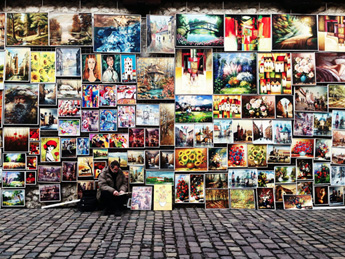
Graphic design once existed as a singular entity in marketing activity, a form of static visual communication, through the use of typography, space and imagery.
While the role of graphic design didn’t initially change with the emergence of the Internet and website development, graphic design soon evolved to meet the demands of screen-based applications, and this advancement continues in order to meet evolving demands.
 Design-driven user experience
Design-driven user experience
Graphic design can be seen to have truly evolved, as it is now integrated into the very infrastructure of modern, skillfully constructed websites. It now delivers not only simple static graphics or brand identity, but is at the very heart of great user experience and site visibility.
Today and in skilled hands, web design will actually deliver such facilities as site navigation, proportion-based grids for responsive web design (RWD) or even high performance search engine optimization (SEO).
It’s intuitive, stupid
High quality, well thought out graphical navigation does not only involve intuitive navigation panel or button design, and therefore good user experience, it also impacts on other fundamentals.
These include SEO, where graphical navigation button design, its naming convention in relation to the button’s destination, all count when search robots crawl your website. For example, if the button was embedded in an image, robots do not crawl most images, so your carefully crafted navigation naming will be invisible.
What will be crawled under these circumstances is the alternative tag (alt tag) and this situation could easily lower your website’s search ranking and visibility.
 Now you see it…
Now you see it…
But the visibility issue is not just confined to navigation and alt tag naming conventions. Some search engines now rank mobile compatible websites higher in search rankings than conventional desktop sites.
This means you need to design using RWD design techniques and technologies. RWD web design techniques create websites designed to provide an optimal user experience on a wide range of devices, from desktop computers, through tablets, to mobile phones.
RWD websites are designed to adapt graphical layout to a given viewing device by using proportion-based grids and flexible images, to offer simple and highly visible navigation with easy-to-read content, and with a minimum of scrolling, panning and resizing.
Words and pictures
While the web design technologies and design techniques discussed here will deliver a great user experience, they may not save you from other issues revolving around website visibility.
While on-page SEO relates to textual content rather than web design, the way content is displayed through graphical design may be critical to web design aesthetics but is equally key to website visibility.
 Lost for words
Lost for words
As most marketing professionals know, there are recognized on-page SEO techniques for maximizing visibility, and these include ensuring key phrases appear in such areas as headlines and in the early parts of paragraph and sentence construction.
However, should this SEO-critical key phrase content be embedded in a picture for aesthetic effect, the words will be rendered invisible to search engine robots and will be lost, significantly reducing your website’s search ranking.
More to it than meets the eye
So, good web design goes much deeper than pure aesthetics. While still a graphical medium, web design can make or break your website in terms of both user experience and search visibility.
Good web design starts with great graphical input, but to be truly successful, web design reaches practically every area of marketing communication.
And here’s the thing: why then entrust your web design to a one dimensional (graphic) web design agency, rather than a multi dimensional digital marketing agency?
This post was originally published on the Novacom blog.
 Now you see it…
Now you see it… Lost for words
Lost for words